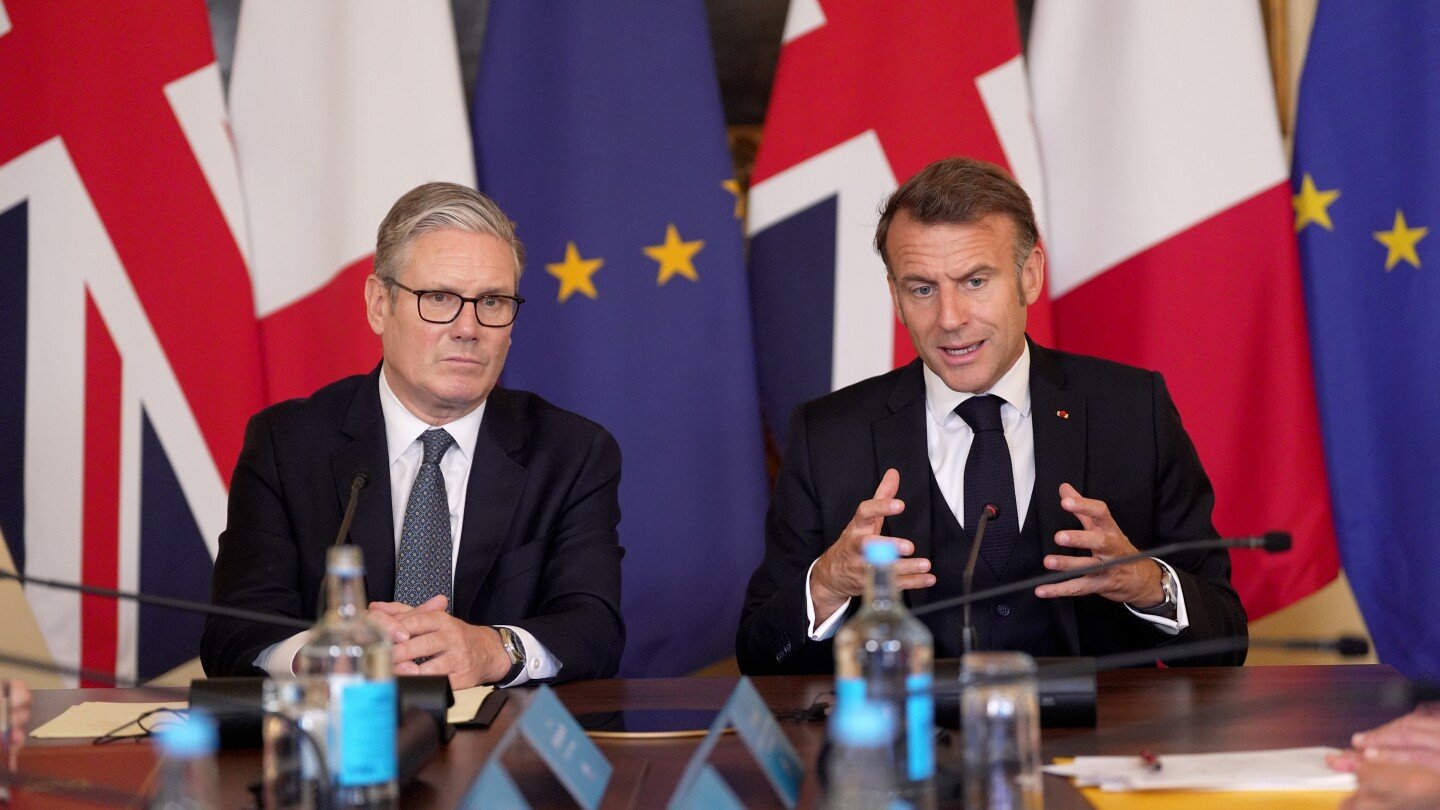Top Stories
UK and France agree to send some migrants arriving in Britain by boat back to France

LONDON (AP) — Britain and France agreed Thursday to a pilot plan that will send some migrants who cross the English Channel on small boats back to France as the U.K. government struggles to tamp down criticism that it has lost control of the country’s borders.
U.K. Prime Minister Keir Starmer and French President Emmanuel Macron announced the deal Thursday in London. While the initial program a limited number of people, U.K. officials suggest it is a major breakthrough because it sets a precedent that migrants who reach Britain illegally can be returned to France.
“There is no silver bullet here, but with a united effort, new tactics and a new level of intent, we can finally turn the tables,’’ Starmer told reporters at a news conference. “For the very first time, migrants arriving via small boat will be detained and returned to France in short order.”
Under the agreement, Britain will send some of those who cross the Channel in small boats back to France while accepting an equal number migrants who are judged to have legitimate claims to asylum in the U.K.
Starmer had pushed for the arrangement, known as the “one in, one out” deal, in hopes of discouraging people from making the dangerous crossing. It is set to begin in weeks.
Small boat crossings have become a potent political issue in Britain, fueled by pictures of smugglers piling migrants into overcrowded, l eaky inflatable boats on the French coast. So far this year, more than 21,000 people have arrived in the UK in small boats, up 56% from the same period last year.
The crossing is dangerous and many have died.
“I’m totally committed to make it work, because this is clearly our willingness and our common interest,” Macron said. He added that the point of the pilot was a “deterrence” effect.
The measure announced Thursday is part of broader efforts to build closer cooperation with France, as well as countries further up the migrants’ routes from Africa and the Middle East.
British officials have been pushing for French police to intervene more forcefully to stop boats once they have left the shore, and welcomed the sight of officers slashing rubber dinghies with knives in recent days.
Macron said earlier this week that he and Starmer would aim for “tangible results” on an issue that’s “a burden for our two countries.”
An issue that has dogged relations between France and that U.K.
As far back as 2001, the two countries were discussing ways to stop the flow of migrants, though at that time they were focused on people stowing away on trains and trucks entering Britain through the tunnel under the channel.
Over the following years, French authorities cleared out camps near Calais where thousands of migrants gathered before trying to reach Britain. Beefed up security sharply reduced the number of vehicle stowaways, but from about 2018 people-smugglers began offering migrants a new route by sea.
“You see that pattern again and again, where smuggling gangs and migrants try to find new ways to cross from France to the U.K.,” said Mihnea Cuibus, a researcher at the University of Oxford’s Migration Observatory. “The authorities crack down on that, and then gradually you see migrants and gangs try to adapt to that. And it becomes a bit of a game of cat and mouse.”
Cooperation on stopping the boats stalled after Britain’s acrimonious split from the European Union in 2020, but in the past few years the countries have struck several agreements that saw the U.K. pay France to increase police and drone patrols of the coast.
Britain’s previous Conservative government came up with a contentious plan in 2022 to deport asylum-seekers arriving by boat to Rwanda. Critics called it unworkable and unethical, and it was scrapped by Starmer soon after he took office in July 2024.
Cuibus said irregular cross-channel migration would likely always be a challenge, but that the measures being discussed by Britain and France could make an impact, “if they’re implemented in the right way.
“But that’s a big if,” he said.
Summit yields deals on defense cooperation plans
The UK-France summit came after a three-day state visit that stressed the longstanding ties between the two countries despite the rupture caused by Britain’s departure from the European Union. Punctuated by carriage rides, banquets and champagne toasts, the two leaders hugged and offered a picture of unity — a step forward to greater cooperation in the future.
The bonhomie was followed by concrete actions. The two leaders sealed deals on defense cooperation, including a pledge to coordinate their nuclear deterrents for the first time.
“Now as Europe’s only nuclear powers and as leaders in NATO, we play a vital role in preserving the peace and security on this continent,” Starmer said.
“From today, our adversaries will know that any extreme threat to this continent would prompt a response from our two nations,” Starmer added.
Progress made on assisting Ukraine
Also Thursday Macron and Starmer visited a military base and dialed in to a planning meeting of the “ coalition of the willing, ” a U.K.- and France-initiated plan for an international force to guarantee a future ceasefire in Ukraine.
Americans attended the meeting for the first time, including retired Lt. Gen. Keith Kellogg, U.S. President Donald Trump’s special envoy to Ukraine and Russia. Republican Sen. Lindsey Graham and Democratic Sen. Richard Blumenthal, who have co-sponsored a new sanctions bill against Russia, were also at the table.
The group agreed to set up its headquarters in Paris to facilitate a rapid deployment after the war ends.
___
Associated Press Writer Brian Melley contributed.
Top Stories
Here are the Powerball winning numbers for Wednesday, Sept. 3, 2025

DETROIT – The Powerball drawing on Wednesday night is worth more than $1.4 billion.
The cash option for the jackpot is $634.3 million.
If someone wins the jackpot, it would be the fourth-largest Powerball jackpot ever and the sixth-largest jackpot in U.S. lottery history.
Michigan last saw a Powerball jackpot winner on Jan. 1, 2024. A Mid-Michigan lottery club won an $842.4 million prize with a ticket purchased in Grand Blanc. That remains the largest Powerball prize ever won in Michigan.
Winning Powerball numbers for Sept. 3, 2025
Powerball numbers: 61-29-69-16-03
Powerball: 22
Powerplay multiplier: 2x
How do you play Powerball?
Powerball tickets cost $2 per play. In Idaho and Montana, the game is bundled with Power Play, making the minimum cost $3 per play. They can be purchased at stores across Michigan or online at MichiganLottery.com.
Players select five numbers between 1 and 69 for the white balls, then one number between 1 and 26 for the red Powerball. Numbers can be chosen manually on a play slip or randomly by the lottery terminal.
The jackpot is won by matching all five white balls in any order and the red Powerball.
Drawings take place every Monday, Wednesday, and Saturday at 10:59 p.m. Eastern time at the Florida Lottery draw studio in Tallahassee.
Jackpot winners can choose to receive their prize as an annuity, paid in 30 graduated payments over 29 years, or as a lump sum. Both prize options are before federal and jurisdictional taxes.
Copyright 2025 by WDIV ClickOnDetroit – All rights reserved.
Top Stories
Explainer: what is Lisbon’s funicular railway Elevador da Glória and how does it work? | Portugal

Portugal is in mourning after at least 15 people were killed when a funicular railway car derailed and crashed on the streets of Lisbon. Witnesses told local media the car appeared out of control as it sped downhill shortly after 6pm during evening rush hour on Wednesday.
Named the Elevador da Glória, the yellow-and-white railway cars are one of the most popular tourist attractions in Lisbon, and date back to the 1800s. Some foreign nationals are among the dead from Wednesday’s derailment but emergency services have not identify the victims or disclosed their nationalities.
First opened in 1885 and electrified in 1915, the Glória is one of three funicular lines run by Lisbon municipal transport company, Carris.
The Glória system is made up of two streetcars running in parallel and hauled by steel cables: so as one descends, its weight pulls the other uphill. Witnesses told local media that they saw one of the streetcars careening down the hill, before crashing into a building where the road bends.
Designated a national monument, the Elevador da Glória carries about 3 million passengers a year.
It takes passengers on a short but steep ride of about 850ft (260 metres), and connects Lisbon’s downtown Restauradores Square with the Bairro Alto – or Upper Quarter – a neighbourhood known for its vibrant nightlife.
Tourists often queue in long lines for the three-minute journey, which offers sweeping views of the city and a chance to ride one of Lisbon’s century-old streetcars along the cobbled streets.
The line is also used daily by local residents to navigate the capital’s steep hills.
Portugal’s president, Marcelo Rebelo de Sousa, offered condolences to families of the victims, while Lisbon’s mayor, Carlos Moedas, said the city was in mourning. “It’s a tragedy of the like we’ve never seen,” he said.
Top Stories
49ers adding $3 million in incentives to Jauan Jennings’ deal

SANTA CLARA, Calif. — After wide receiver Jauan Jennings returned to practice Monday and participated again Wednesday, the San Francisco 49ers bolstered his earning potential for 2025.
Jennings’ agents, Drew and Jason Rosenhaus, told ESPN’s Adam Schefter on Wednesday night that the Niners and Jennings have agreed to add $3 million in play-time incentives to his contract for this season.
Jennings, who is entering the final season of the two-year contract he signed last offseason, can now earn up to $10.5 million. He is slated to become an unrestricted free agent after the season, as he and the Niners didn’t come to an agreement on a long-term extension.
Earlier Wednesday, Niners coach Kyle Shanahan said he didn’t think “there’s totally a resolution” with Jennings in terms of his contract, though he reiterated that the team would like to keep Jennings for 2025 and beyond. It was an indication that at least some contract modification could be coming, however.
“There’s a business side but it’s something that I think both sides would love to get worked out,” Shanahan said. “Just don’t know if we can.”
While much was made of Jennings’ contract situation during the 36 days of camp and the preseason he missed, he also was dealing with a calf injury that he suffered in the fourth practice of camp.
Shanahan said Wednesday that Jennings had imaging done before the team returned to practice Monday and that it showed the wideout is “good to go.” Jennings was listed as a limited participant in Wednesday’s practice, though Shanahan said Jennings will be ready to play in Sunday’s regular-season opener against the Seattle Seahawks.
“Having him back on the practice field Monday was awesome,” Shanahan said. “We love J.J. When he is not there, he is greatly missed. The way he carries himself, the energy he plays with and how good of a player he is makes everyone very excited.”
San Francisco general manager John Lynch acknowledged last week that Jennings had requested a trade “a while ago” but said the team and player had moved past that, adding that the Niners had no interest in trading Jennings and that he would be expected to play once his calf healed.
That, apparently, happened in recent days, clearing the path for Jennings to return to practice and for him and the Niners to find a way to bolster his contract for this season. It’s a similar playbook the Niners have followed for other players who have requested trades in the past.
Running back Raheem Mostert, receiver Deebo Samuel and kicker Robbie Gould have all requested trades in recent years, with the 49ers declining to deal them before either signing them to an extension (Samuel, Gould) or adjusting their contract (Mostert).
Jennings is coming off his best professional season. In 2024, he was the team’s most productive wideout, posting 77 receptions for 975 yards and six touchdowns, all career highs. The Niners also view Jennings as an elite run blocker for his position.
“I’m obviously super happy [he’s back],” defensive end Nick Bosa said. “He came back on whatever our last practice was and already looked great making plays, so obviously that’s huge for us.”
In other receiver news Wednesday, the 49ers signed Marquez Valdes-Scantling to the active roster and re-signed veteran Russell Gage Jr. to the practice squad. Shanahan indicated that Valdes-Scantling and Gage will be active against the Seahawks on Sunday to go along with Jennings, Ricky Pearsall and Skyy Moore at the position.
-

 Business5 days ago
Business5 days agoThe Guardian view on Trump and the Fed: independence is no substitute for accountability | Editorial
-
Tools & Platforms3 weeks ago
Building Trust in Military AI Starts with Opening the Black Box – War on the Rocks
-

 Ethics & Policy1 month ago
Ethics & Policy1 month agoSDAIA Supports Saudi Arabia’s Leadership in Shaping Global AI Ethics, Policy, and Research – وكالة الأنباء السعودية
-

 Events & Conferences4 months ago
Events & Conferences4 months agoJourney to 1000 models: Scaling Instagram’s recommendation system
-

 Jobs & Careers2 months ago
Jobs & Careers2 months agoMumbai-based Perplexity Alternative Has 60k+ Users Without Funding
-

 Education2 months ago
Education2 months agoVEX Robotics launches AI-powered classroom robotics system
-

 Funding & Business2 months ago
Funding & Business2 months agoKayak and Expedia race to build AI travel agents that turn social posts into itineraries
-

 Podcasts & Talks2 months ago
Podcasts & Talks2 months agoHappy 4th of July! 🎆 Made with Veo 3 in Gemini
-

 Podcasts & Talks2 months ago
Podcasts & Talks2 months agoOpenAI 🤝 @teamganassi
-

 Education2 months ago
Education2 months agoAERDF highlights the latest PreK-12 discoveries and inventions





















